Practical fire safety for existing specialised housing and similar premises: guidance
Guidance for those who are responsible for specialised housing and for those who provide care and support in such premises.
Chapter 5: Risk Management – Fire Protection
Key Points
- Benchmarks are used to assess the standard of existing fire safety measures.
- Buildings may sometimes need upgrading to current benchmarks to address unacceptable risk.
- When upgrading fire safety measures, fire protection products and services should be fit for purpose and properly installed.
- Third party certification schemes are available for many products and services.
Introduction
232. This Chapter is about assessing physical fire safety measures which are designed to protect people in the event of fire. Measures required where a “stay put” policy applies are significantly different to those where a “simultaneous evacuation” policy applies.
233. The measures described in this Chapter are benchmarks, not prescriptive standards. They should be used to assess whether existing measures are appropriate. The aim should be to achieve an integrated “package” of fire safety measures. Care should be taken not to consider any specific fire safety measure in isolation.
234. It is often possible to minimise cost by delaying work that is not of an immediate priority to coincide with capital maintenance programmes. Depending on risk and priority, it may be possible for works affecting private accommodation to be scheduled for when the premises are vacant, avoiding disruption for vulnerable residents.
Methodology for using Benchmarks
235. It is important to compare existing standards against appropriate benchmarks, before making judgements about the adequacy of the fire safety measures.
236. The standards that applied when the premises was built should be established to determine how far removed they are from what is acceptable today, and whether that gives rise to an unacceptable level of risk.
237. There have been many variations in the fire safety design of domestic buildings over time. For example, since May 2005, automatic fire suppression systems have been a requirement in all new sheltered housing complexes.
238. With older premises, it may be difficult to discern the original design intent and whether it has been preserved or altered. For example, fire separation can be difficult to assess, given that elements of structure are often hidden and inaccessible.
239. Upgrading to current benchmarks must always be justified on the basis of risk, taking into account the time, cost and disruption involved. They are not standards to be applied prescriptively.
Third-party Certification
240. Fire safety products and related services should be fit for purpose, properly installed and maintained in accordance with the manufacturer’s instructions or a relevant standard.
241. Third-party certification schemes provide an assurance of quality, reliability and safety. Goods and services that are not third-party approved are not necessarily less reliable, but there is no obvious way in which this can be demonstrated.
Fire Separation in Sheltered and Extra Care Flats (“stay put”)
242. Fire separation restricts fire and smoke spread between areas in different occupation, such as between individual flats and between flats and common areas. A flat’s fire-resisting enclosure should include:
- The flat entrance door.
- Internal windows into an access corridor.
- Glazing above or around the flat entrance door doorways.
- Hatches in walls for access to read meters or for deliveries.
243. A ‘stay put’ strategy relies on adequate separation so that only the occupants of the flat of fire origin would need to evacuate, while the occupants of flats unaffected by a fire should be safe to remain in their flats. Design guidance recommends the following:
- Separating walls and floors may be constructed from combustible materials provided the appropriate fire resistance duration is maintained (wall linings and insulation used in a cavity should achieve European Classification A1, A2, or B).
- Separating walls and floors between individual flats and between flats and any other part of the building in common occupation, including common access corridors, to have a minimum fire resistance of 60-minutes.
- A separating wall enclosing a lift well to have a minimum fire resistance of 60-minutes (NB A platform lift constructed in accordance with the guidance in BS 6440 need not be enclosed by separating walls or separating floors).
- Self-closing fire doors in separating walls to have a minimum fire resistance of 30-minutes.
- Junctions between separating walls and separating floors and other parts of the building should be designed and constructed in such a way to prevent a fire in one part of the building flanking the separating wall or separating floor and entering another part of the building under different occupation, including any solum space or roof space.
244. The lines of separation between flats located on the top floor of a building should extend through the roof void in a continuous vertical plane to the underside of the roof (see Figures 2 and 3). This ensures the fire-resisting ‘box’ principle extends into the common roof voids, preventing fire spread between flats via the void, and from a flat into other areas of the building (see Figures 4, 5 and 6). Cavity barriers may not provide adequate separation; placing them at regular intervals is unacceptable.
Figure 2: Separating Walls within Roof Void
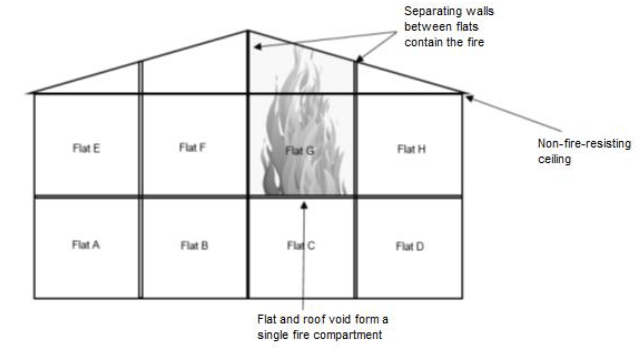
Figure 3: Separating Wall junction with Roof
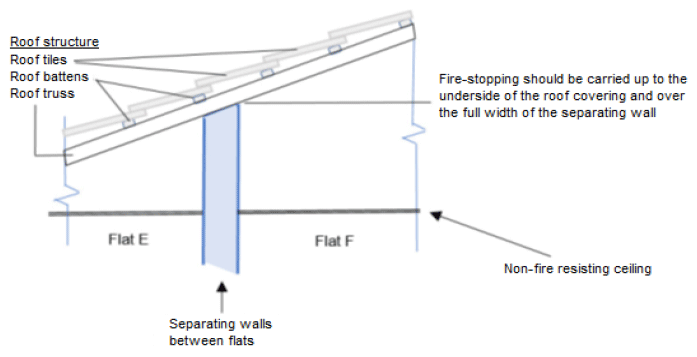
245. Fire-resisting ceilings in top floor flats (see Figure 4) would not normally achieve an equivalent standard of safety. It fails to address the possibility of a fire within the roof void (see Figure 5) or that enters the roof void externally (for example, as a result of flames projecting from a top storey window – see Figure 6). A fire-resisting ceiling protects against fire-spread from a flat into the roof void, but not normally vice versa (unless double facing).
Figure 4: Fire Resisting Ceiling and Cavity Barriers in Roof Void
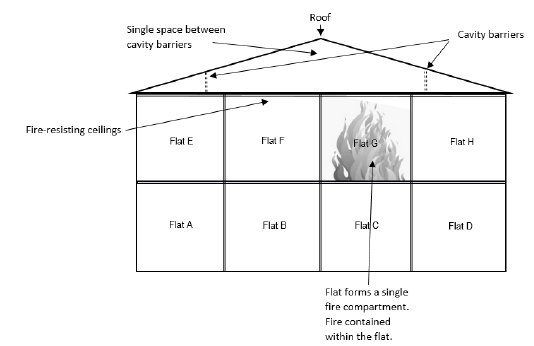
Figure 5: Fire within Roof Void
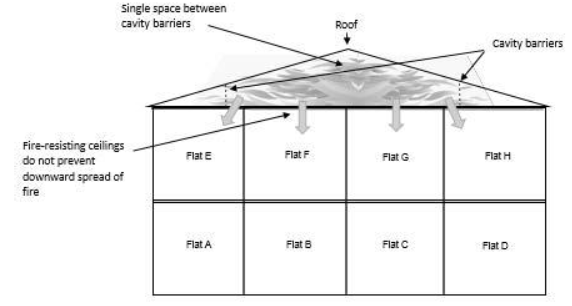
Figure 6: External fire spread from Flat to Roof Void
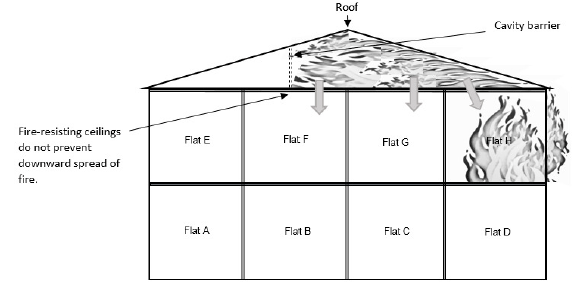
246. If there is no separation within roof voids, fire-resisting barriers should be provided in line with every separating wall between flats. It may be appropriate to plan structural work over a period of time, particularly if other fire safety measures take priority. This should be reflected in the fire safety risk assessment Improvement Plan.
247. Previous design standards permitted a lower level of fire resistance in buildings. Compensatory measures may be needed in existing blocks which do not have 60 minutes’ fire resistance separation, particularly if they cannot be easily upgraded. These measures might include an automatic fire suppression system, such as a sprinkler or watermist system.
248. Separating walls and floors should be in good condition and have no openings that would permit fire or smoke spread. Attention should be paid to service ducts and risers and common heating or ventilation systems.
249. Where balconies have been infilled and incorporated into flats, fire separation and fire stopping between flats should be checked.
250. Ducted heating, ventilation or air conditioning systems that serve dwellings, should be arranged so that they do not transfer fire and smoke. This may involve fire resisting construction and fire dampers.
251. Fire stopping should be checked around openings in walls and floors for services such as gas, water, electricity, telecommunications and drainage. Services may enter from the common areas or pass between flats. Sometimes the extent of openings or fire stopping can only be ascertained through intrusive inspections, by opening up panels in kitchens, bathrooms and other areas.
252. Small bore pipes, typically less than 40mm in diameter, are not normally of concern. Larger pipes, especially if combustible, could allow significant fire and smoke spread. Proprietary fire seals, including externally mounted collars or fire-resisting enclosures, might be used to protect older blocks. It may only be practicable to undertake this on a long-term basis as and when flats become vacant.
253. In some blocks of flats, common ventilation ducts are used to provide extract from bathrooms and, less commonly, kitchens. These ducts can run the full height of the building, serving a large number of flats and terminate at roof level.
254. The common extract from bathrooms often incorporate shunt ducts to link each flat to the common shaft, which reduces the likelihood of fire and smoke spread between flats (Figure 7). Some early designs used the same arrangement for kitchen extract. There may be buildings that do not incorporate shunt ducts and have no adequate means of preventing fire and smoke spread between flats via ventilation ducts. This is so far removed from what is acceptable today that action should be taken to reduce the risk.
Figure 7: Shunt duct arrangement
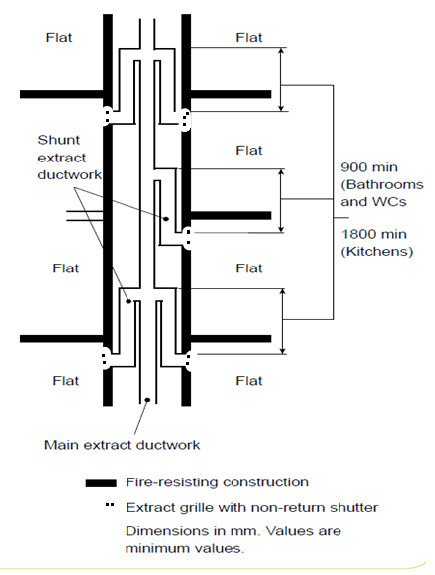
255. It will rarely be practicable to retrospectively introduce mechanical fire and smoke dampers into the ventilation ducts. One way to reduce the potential for fire spread between flats is to retrofit intumescent fire dampers to the vents into the ducts. Although this would not restrict the spread of smoke in the early stages of a fire, it would prevent spread of flames and hot gases. This is a reasonable approach for bathrooms, but not for kitchens, where there is the potential for a serious fire. A solution would be to rearrange the ventilation to discharge directly to outside and not via a common duct.
Fire Separation and Structural Protection in Supported Housing and small care homes (“simultaneous evacuation”)
256. If supported housing is provided in purpose-built blocks of flats, the fire separation principles for sheltered and extra care housing would apply, as would a ‘stay put’ strategy. In semi-detached or terraced housing, fire separation between dwellings should also be considered to prevent fire spread from an adjoining property.
257. Most supported housing comprises properties similar in design to domestic houses. Many were originally single-family dwellings that have been subsequently converted. The evacuation strategy will be simultaneous evacuation of all occupants in the event of a fire. A degree of internal structural fire protection will be required to protect the means of escape and limit fire spread.
258. Current design guidance requires that structural elements such as floors and load bearing walls should provide at least 30 minutes fire resistance duration. For premises with a storey height above 7.5m (over 3 storeys), they should provide 60 minutes.
259. Lath and plaster ceilings in good condition may be acceptable in lower risk properties of up to three storeys, otherwise floor/ceiling construction should achieve at least 30 minutes. For premises with more than 3 storeys, upgrading to 60 minutes should be considered and will be appropriate for higher risk supported accommodation. Upgrading will not be necessary if the premises are protected by a sprinkler or watermist system.
260. Ceilings should be visually examined for damage or other breaches of integrity. Defects affecting fire resistance or allowing smoke spread must be repaired.
261. Cavity barriers will not normally be necessary to sub-divide roof voids. However, they should be provided above stairway enclosures in properties of three storeys or more (excluding any basement storey). Alternatively, it would be acceptable to either install smoke detection within the roof space, or to install a ceiling that would afford resistance to a fire in either the stairway or the roof void (e.g. comprising fire-resisting board within both the void and the stairway. See Figure 8).
Figure 8: Methods of separating a protected stair from the roof space
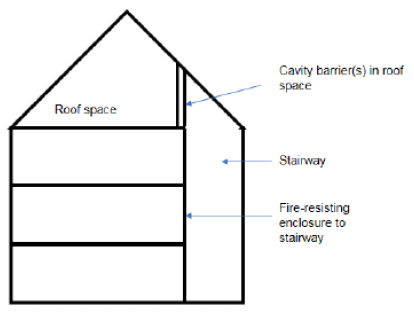
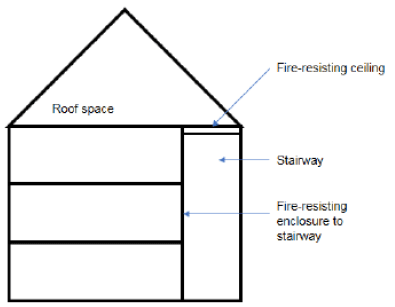
Means of Escape
262. Depending on the type of accommodation, means of escape comprises:
- Escape from within an individual dwelling; and
- For flats, continued escape using the common horizontal and vertical routes in a building, to a final exit leading to a place of ultimate safety outside.
263. In general needs flats and houses with no floor above 4.5m, an escape window is recognised as an alternative option for escape. This will not be appropriate for most residents covered by this Guidance and so the use of escape windows is not considered further.
264. The following section deals with means of escape in Sheltered, Extra Care and other private dwellings. Means of escape in supported group housing and small care homes will be considered separately at paragraph 338.
(1) Means of Escape in Sheltered, Extra Care and other private dwellings
265. Flats in sheltered and extra care schemes are normally single level. A fire anywhere in a dwelling should not prevent the occupants from escaping. Design guidance recommends three acceptable approaches to providing means of escape from dwellings where all rooms and the entrance door are on a single level:
- Limit the travel distance within the dwelling.
- Provide a protected internal hallway.
- Provide an alternative exit.
266. The risk assessment should take account of generic characteristics, such as age, mobility and vulnerability of the residents. Slightly increased travel distances of up to 3m might not require additional measures. More significant deviations might indicate that compensatory measures are necessary. A person-centred risk assessment should be used to determine appropriate measures on an individual basis (see Part 1 of the Guidance). Compensatory measures might include Category LD1 fire detection, fire-resisting doors to the kitchen and lounge or an automatic fire suppression system.
Dwellings with limited travel distance
267. The travel distance from any point in a habitable room to the flat entrance door is limited, reducing the chance that residents could become trapped in the event of a fire. This approach avoids the possible difficulty of older residents having to open heavy internal fire-resisting doors (particularly doors fitted with self-closing devices) as part of everyday living.
268. The arrangement is common in existing housing and requires that:
- The travel distance from any point in a habitable room to the entrance door should be limited to 9m.
- Cooking facilities should be remote from the entrance door and should not prejudice the escape route from any point in the dwelling.
269. BS 9991 contains further information.
Dwellings with protected internal hallways
270. For some flats which open directly onto a communal stairway, fire protection of the flat’s internal hallway provides protection for the flat and externally, to the communal escape route.
271. Where there is a protected internal hallway (also known as a “protected enclosure”), the escape route within the dwelling should remain relatively smoke free in the early stages of a fire in a room. Current design guidance advises:
- All dwellings with a storey above 4.5m should have a protected internal hallway or suppression.
- Houses and maisonettes with a storey above 7.5m (less than 18m) should have a protected internal hallway and suppression/alternative exit.
- Habitable rooms should open onto the internal hallway.
- The internal hallway should be a protected route, enclosed in 30 minutes fire-resisting construction with fire doors (FD30 doors).
272. In older buildings, the fire resistance of partitions and doors may not meet current standards. Replacing or upgrading doors or partitions may be necessary, depending on the overall risk. An automatic sprinkler system that complies with BS 9251, or a watermist system that complies with BS 8458 could compensate for lower levels of fire resistance.
273. A person-centred risk assessment will determine whether internal self-closing doors pose a risk to older, frailer residents. Swing-free self-closing devices may be more appropriate (see paragraph 325)
Dwellings with an alternative exit
274. Current design guidance states:
- Habitable rooms should be directly accessible from an internal hallway and have an alternative exit remote from the entrance door; or
- All bedrooms should have access to an internal lobby that is separated from the living area (lounge and kitchen) with 30 minutes fire-resisting construction; an alternative exit is then provided from the bedroom area.
275. For an arrangement that relies on alternative exits, each alternative exit should lead to a final exit or common stairway by way of:
- A door to a common corridor, lobby or escape balcony;
- An internal private stair leading to a common corridor, lobby or escape balcony;
- A door to a common stairway; or
- A door to an external stairway.
Inner rooms
276. An inner room is one where escape is only possible by passing through another room (the “access room”). They can be found in larger flats and open plan layouts. Works carried out by residents might also create inner rooms. A fire could develop unnoticed in an access room, preventing the occupants of the inner room from escaping. To reduce this risk, access rooms should have a smoke detector and limited combustible items and ignition sources.
277. Habitable rooms, such as lounges and bedrooms, should not normally be inner rooms, particularly for higher risk individuals or where the access room is a higher risk room. Where possible, habitable rooms should open directly onto a hallway or be provided with an alternative exit. BS 9991 advises that automatic fire suppression may offer compensation in general needs open plan flats with inner room sleeping accommodation, but this is not normally appropriate for flats in sheltered and extra care housing.
Security locks
278. Security locks fitted to entrance doors and alternative exit doors should be easily operated by the residents from the inside without the use of a key.
279. Flat entrance doors are required to be self-closing. Residents may remove or disconnect self-closing devices for convenience or to prevent being accidentally locked out. Entrance doors should be fitted with a suitable lock that can only be locked on the outside by the use of a key operated deadlock, but that can still be opened from the inside without the use of a key.
Escape routes within common areas
280. Smoke and heat from a fire in a flat or ancillary room should not affect the use of the corridors, lobbies, balconies or stairways. To achieve this, current design guidance limits the travel distance from a flat entrance door to a protected stairway, requires escape routes to be enclosed in fire-resisting construction and requires smoke control to ventilate corridors/lobbies and stairways.
281. Where flats are served by a single escape stairway:
- Every flat is separated from the common escape stairway by a protected corridor or protected lobby (except as described in paragraph 285).
- The distance of travel between the flat entrance door and the door to a lobby or stairway is limited to 10m.
- Smoke control is provided by natural or mechanical ventilation automatically activated by smoke detection within each lobby or corridor adjacent to the stairway.
- The stair is provided with a smoke vent at the head (normally under remote control for fire service use) or by manually openable vents on each level or by a smoke shaft arrangement incorporating the simultaneous automatic opening of the lobby vent, stair head vent, and the vent at the top of the smoke shaft.
282. The escape stair should be safe from the effects of fire and smoke while residents evacuate to a place of safety. The enclosing structure of a protected zone incorporating an escape stair should have at least 60 minutes fire resistance and any door should achieve at least 30 minutes fire resistance.
283. A protected lobby restricts the movement of fire and smoke from an adjoining room, storey or space into the escape stair. This is normally achieved by fire resisting construction together with at least 2 sets of self-closing fire doors between the fire and the escape stair. The wall between the protected lobby and the escape stair should achieve 30 minutes fire resistance duration and any door in the wall should be a self-closing fire door with 30 minutes fire resistance duration (see Figure 9 below).
Figure 9: Single Stair Protected Lobby
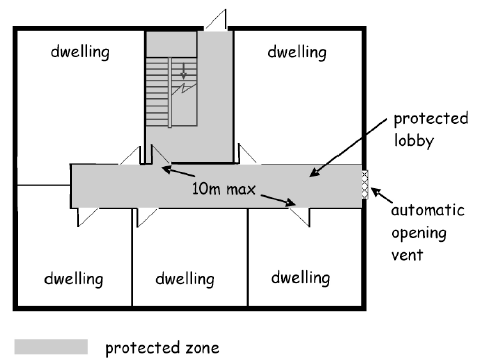
284. Ancillary rooms, risers and other areas opening onto corridors and lobbies also need to provide this protection. Doors opening into corridors and lobbies should have a minimum of 30-minutes fire resistance. They should be self-closing, except for risers and ancillary rooms which may be kept locked shut when not in use.
285. Protected lobbies are not required where all of the following apply:
- No storey is over 7.5m above adjacent ground level.
- There are no more than 4 dwellings per storey.
- Flats have protected internal hallways or automatic fire suppression.
This limits the size and height of a domestic building where some reliance is placed on the fire precautions in a dwelling to protect the common escape route.
286. A stairway width of 1m is normally adequate for means of escape. With a stay-put policy, the number of people expected to use a stairway at the same time in the event of a fire will be limited.
287. Some residents will find it difficult to use stairs in the event of fire and additional measures may be needed, such as temporary waiting spaces within a protected stair or lobby. External stairways are unsuitable.
288. Stairways should lead directly to a final exit (or a protected route to a final exit). They should not contain significant fire hazards, other than lifts or protected electrical meter cupboards. Ideally, gas installations should not be located within protected stairways.
289. In single stairway buildings, the stairway should not continue down to serve a basement or enclosed car park. In multiple stairway buildings, one of the stairways should terminate at ground level. Other stairways may extend to serve basements, providing they have lobby or corridor protection at basement level.
290. In single stairway buildings, the stairway should not serve a boiler room, fuel storage room or other similar high-risk ancillary rooms. In multiple stairway buildings, the ancillary rooms should normally be separated from the stairways by a protected lobby or protected corridor.
291. Where flats are served by more than one escape stairway:
- Stairways should be separated from each other by fire-resisting construction so that a fire cannot affect more than one stairway (stairs should not terminate in the same enclosure).
- Every flat is separated from each escape stairway by a protected corridor or protected lobby.
- The travel distance from a flat entrance door to the door to the nearest stairway or stair lobby is limited to 30m.
- Any dead end section of an access corridor is separated from the rest of the corridor by a self-closing fire-resisting door – the single direction of travel in the dead end section of corridor should be limited to 10m.
- Smoke control by natural or mechanical ventilation is provided in each lobby or corridor adjacent to the stairway and is actuated automatically by smoke detection.
- There is a smoke vent at the head of the stair (normally under remote control for fire service use) or by manually openable vents on each level or by a smoke shaft arrangement incorporating the simultaneous automatic opening of the lobby vent, stair head vent, and the vent at the top of the smoke shaft.
Figures 10 and 11 show these arrangements.
Figure 10: Upper floor arrangement where flats are served by more than one escape stairway
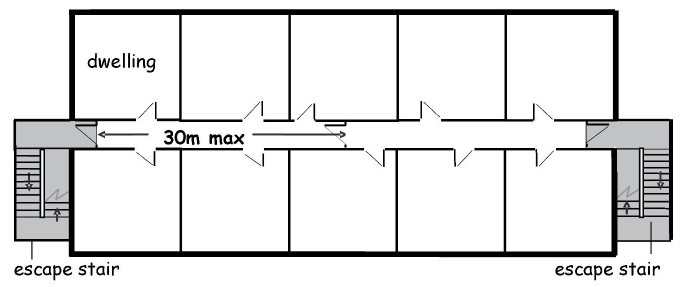
Figure 11: Upper floor arrangement where flats are served by more than one escape stairway and there are dead ends
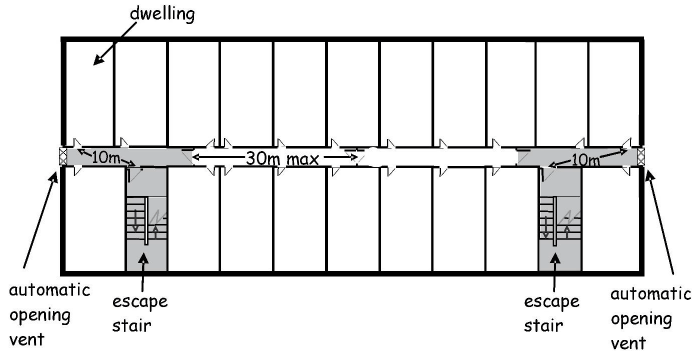
292. BS 9991 recommends that residents with assistance requirements should travel no more than 7.5m from a flat entrance door along a corridor or lobby to reach a fire door to a protected stairway, protected lobby to the stairway or a cross-corridor fire door. This principle should apply to sheltered housing, where practicable, and extra care housing, with a maximum permissible travel distance of 10m.
293. Small increases in travel distance can be accepted in most situations without additional measures. Significant increases in travel distance might require:
- Additional cross-corridor doors to restrict smoke-spread.
- Improvements to the smoke control arrangements.
Flats with external balcony or access deck approach
294. If the width of the access balcony or deck is less than 2m, it is assumed that there is little risk of horizontal smoke spread along the balcony or deck from a fire in a flat, which would prevent residents from using the escape route. There is, however, potential for smoke-spread along balconies or decks wider than 2 m. In these situations, downstands (minimum 300mm deep) may restrict the lateral spread of smoke.
295. Ideally, there should be no stores or other ancillary rooms, located off the balcony or deck.
296. The maximum travel distance for a common access balcony or deck is 40 m. For flats with external balcony or deck approach and the balcony or deck provides two directions of escape, there are no limitations on travel distance.
297. For flats with a single direction of escape to a single escape stairway, the separating walls between the flats and the balcony or deck should be fire-resisting up to a height of 1.1m from balcony or deck level. The flat entrance doors in these situations should be self-closing fire-resisting doors (minimum 30-minutes). This will allow residents, if they need to pass a fire in an adjoining flat, to reach the stairway. In flats with alternative independent escape to another balcony or deck on the same level, which leads back to the single stairway, only one of the enclosures between the flats and the balcony needs to be fire-resisting.
298. For residents who require mobility aids, such as wheelchairs and mobility scooters, the 1.1m fire-resisting barrier may not allow some residents to safely pass beneath open windows or unprotected areas.
299. Where there is alternative escape available from each flat entrance along the open balcony or deck to two or more escape stairways, the separating walls between the flats and access balcony or deck and the balcony flat entrance doors are not required to be fire-resisting.
Smoke control
300. Subdividing corridors and separating dead end sections of corridors, using fire-resisting, self-closing doors is a form of smoke control. It ensures that corridors and stairways not directly affected by fire and smoke will remain relatively smoke free. Additional cross-corridor doors in sheltered and extra care housing reduces travel distance and, consequently, the length of corridors that may be affected by smoke. This recognises that older and less mobile residents will take longer to reach a place of safety.
301. Where a “stay put” strategy applies, protected lobbies, protected corridors and escape stairs should have additional measures for smoke control which can be achieved by natural means, using the buoyancy of smoke, or mechanical means. Natural ventilation efficiency, in particular, often depends upon the prevailing wind.
302. With natural ventilation, lobbies and corridors are ventilated where they adjoin a stairway, at a high level, by means of an automatically opening external wall ventilator (AOV) direct to open air or via a natural smoke shaft. AOVs which discharge direct to the external air should have a minimum area of 1.5m2. A smoke shaft rises up through the building and is usually found where the lobby or corridor does not have an external wall to allow direct ventilation to external air. It has a minimum 1.5m2 opening at roof level and AOVs in each lobby into the shaft should have a minimum 1m2 area. Replacement air is supplied by an AOV in the adjacent stairway. The shaft should have a minimum fire resistance of 60-minutes and all ventilators have a minimum fire resistance of 30-minutes. On detection of smoke in the protected lobby, the ventilator on the fire floor, the ventilator at the top of the smoke shaft and the 1m2 ventilator at the head of the stairway should all open simultaneously. The ventilators from the protected lobbies on all other storeys should remain closed.
303. Protected stairways should have means to ventilate smoke that may enter the stairway. A vent of at least 1m2 is normally provided at the head of the stairway. This vent is usually operated manually (which can be electrically powered), unless an AOV is required as part of a smoke shaft arrangement in which case the vent is configured to operate if smoke is detected in a protected corridor or protected lobby. In older properties, openable vents at each level may be provided in lieu of a stair vent at the head of the stair.
304. It is important that firefighters can control the opening and closing of the ventilators on arrival at the building. Ventilators should be fitted with a simple handle or lock that can be easily operated by firefighters. If ventilators are not easily accessible they should be operated by a mechanism positioned at the SFRS access point in the building. In the case of an escape stair and firefighting stair, a local control should also be provided at the topmost storey. This will allow firefighters flexibility in their operations.
305. Electromagnetic holding devices for ventilators have been known to fail under fire conditions due to a loss of power or weakening magnetic fields as temperatures in and around the smoke shaft increase. In light of this, fire safety risk assessments should be reviewed and consideration given to replacing them with more robust vent actuators.
306. A mechanical smoke control system can be a mechanical ventilation system or a pressurisation system. A mechanical ventilation system extracts from the lobby or corridor by creating a negative pressure in the space using fans. Most systems use a vertical shaft. The shaft contains an AOV of 1m2 at the top storey.
307. A pressurisation system works on the basis of forcing air into a space to create a positive pressure to prevent smoke from entering. Pressurisation systems are most commonly found protecting stairs.
308. A system installed to maintain environmental conditions should be arranged so that it does not compromise the function of the smoke control system. In the event of fire, the system should either automatically shut off or, if it is integrated with the smoke control system, should operate in fire mode.
309. An existing smoke control system should be assessed by reviewing the standards in place at the time of installation, and determining whether it functions as originally intended. Existing arrangements may be able to be left in place, and maintained as originally designed. It may not be appropriate to commit expenditure to restore older, non-functioning systems to their original design if effective smoke control could be installed in line with modern standards.
310. Corridor smoke control design has changed over time. Previous design guidance included a smoke dispersal strategy, where reliance was placed on cross-ventilation of corridors, uninterrupted by cross-corridor doors. The cross-ventilation could be provided by permanently open vents (PV), manually operated vents (OV) or automatically opening vents (AOV) operated by smoke detectors.
311. Smoke dispersal using PVs is no longer seen as an acceptable method of smoke control. It has been shown to be vulnerable to failure as a result of wind direction or being undermined by residents blocking the permanent vents because of discomfort. In high rise domestic buildings designed with corridor smoke dispersal systems, consideration should be given to providing cross-corridor doors and to change to a smoke containment approach, but maintain the OVs or PVs to ventilate the sections of corridor remaining. Advice from a specialist should be sought if smoke dispersal is present in a single stairway building.
Lifts
312. Specially designed evacuation lifts are safe for residents to use for vertical escape during a fire. Normal passenger lifts can sometimes be upgraded to evacuation lift standards (usually at the time of lift refurbishment). This requires dual power supplies, which can be created by running two independent, fire-resisting circuits via diverse routes. Evacuation lifts should comply with the recommendations of BS 9999. It is possible for a modern firefighting lift to be used as an evacuation lift without modification, although discussions with SFRS will be required to determine whether this is feasible (its use for evacuation may impede firefighting operations).
313. In exceptional circumstances in sheltered and extra care housing, the use of normal passenger lifts for evacuation, under the supervision of staff or SFRS, might be considered. This needs to be based on a careful risk assessment that takes into account the likelihood of failure of power supplies to the lift, and entry of smoke into the lift shaft, during a fire. If vertical evacuation of residents is essential, using a passenger lift with fire-protected power supplies might be less hazardous to residents with severe mobility impairment than evacuating them down a stairway.
Surface finishes in common escape routes
314. It is particularly important to control the fire performance of linings within the common areas. The surface finishes of walls and ceilings can significantly affect the rate of fire-spread and contribute to the development of a fire. Wall and ceiling surfaces in common areas should achieve European Class A1, A2 or B (BS EN 13501-1).
315. Walls or ceilings constructed of non-combustible materials, such as masonry, brick, concrete or has plaster finishes, will generally be acceptable.
316. It is often difficult to identify existing surface finishes. Surface finishes may have been subject to many instances of over-painting which can affect their performance when exposed to fire. Multiple layers of paint applied to walls and ceilings in the common areas over the years can give rise to rapid fire spread. Where this risk is considered significant, action should be taken to remove or treat the paint. Proprietary products are available that can be used to treat the surfaces to provide a protective outer coating that will reduce the extent of fire-spread.
317. False ceilings in common corridors and lobbies should preferably be non-combustible (A1 or A2). There should be little, or no, additional fire hazards within the false ceilings. Subject to risk assessment, this may reduce the need for cavity barriers to sub-divide the voids, other than above cross-corridor fire doors.
Fire-resisting doors
318. A ‘fire door’ is a fire-resisting door which is rated by performance to fire under test conditions. Fire doors are used to prevent fire spread and for the protection of means of escape. A self-closing device is a normal feature of a fire door, though there are some exceptions such as doors to small cupboards which are kept locked shut.
319. A fire door rated to 30 minutes is described as FD30 (tested to BS 476: Part 22) or E30 (tested to BS EN 1634: Part 1). A suffix is added to denote that the door has a smoke seal function giving FD30S and E30Sa respectively. A 60 minutes fire door with smoke seal is designated FD60S or E60Sa. The door rating is an indication of test performance and is not necessarily how a door will perform in a real fire.
320. The level of protection provided by a fire door is determined by the time taken for a fire to breach the integrity of the door assembly, together with its resistance to the passage of smoke, hot gases and flame. The gap between the door leaf and the frame is normally fitted with intumescent strips, in either the door or the frame (but not at the bottom of the door). The strips expand in response to heat from a fire, to seal the gap between the door leaf and the frame.
321. Smoke seals fitted to the door leaf gap prevent the spread of smoke at ambient temperatures, before an intumescent strip expands.
322. In determining the performance of a door in fire, it is necessary to consider the whole door assembly including the frame, glazing, side-panels, transoms and ironmongery. In the case of a new door assembly, the manufacturer’s installation instructions should be followed.
323. Doors protecting the common escape route between a flat and the escape stair, including flat entrance doors, are specified as minimum 30-minute fire-resisting self-closing doors (designated FD30S). Fire doors forming part of the stair enclosure should also be a minimum of 30-minute fire resisting and self-closing. Doors to certain high risk ancillary rooms, such as boiler rooms, should be FD60S. Doors to these ancillary rooms need not be fitted with self-closing devices if the premises are well managed and the doors are kept locked shut when not in use.
324. Fire-resisting flat entrance doors, and doors provided to protect common corridors, lobbies and stairways, should always be fitted with suitable positive action self-closing devices. The self-closing device should be capable of closing the door in its frame from any angle and overcoming the resistance of a latch. Where this is not the case, the fitting of suitable self-closing devices should be a priority.
325. Where fire-resisting, self-closing doors, particularly those in common corridors and circulation spaces, present an obstacle to normal movement for older and disabled residents, consideration should be given to the fitting of hold-open devices or swing-free devices. Hold-open devices are designed to hold a door open against the action of the self-closing device. Swing-free devices allow a door to stand open at any angle in normal use. Both types of device automatically result in closure of the door in the event of fire. New hold-open devices and swing-free closers should conform to BS EN 1155. The fitting of hold-open devices or swing-free door closers in sheltered and extra care housing can only be permitted if there is a suitable fire detection and alarm system fitted throughout the areas where these devices are used. Recommendations for the fire detection are given in BS 7273-4. Hold-open devices and swing-free closers should release to allow the door to close under the action of the self-closing device on operation of the fire alarm system and the failure of the power supply. Acoustically-actuated hold-open devices are not acceptable on doors to protected stairways. BS 7273-4 provides recommendations for the design, installation, commissioning and maintenance of door release mechanisms.
326. Powered doors, or powered door opening devices on existing doors, can assist residents who use wheelchairs or mobility scooters. These doors are normally fitted with controls on each side of the door. They close automatically after a pre-set time has elapsed. Doors should fail safe to the closed position in the event of failure of the power and be capable of manual operation. Any in-built delay should be restricted to a maximum of 25 seconds to restrict smoke spread.
327. There are three options for original fire-resisting doors that do not meet current standards:
- Accept the door as it is, provided it is a good fit in its frame, is in good condition, and that it satisfied the standard applicable to fire-resisting doors at the time of construction of the building.
- Upgrade the door by fitting intumescent strips and smoke seals along the edges, and in the case of flat doors, fitting a protected letter box.
- Replace the door with a new FD30S door.
328. Older doors which are solid and 44mm thick may provide a notional 30-minute fire-resistance. They may be acceptable providing they are in good condition. They may lack intumescent strips and cold smoke seals and there may have been reliance on 25 mm door stops but usually strips and seals can be easily fitted retrospectively to doors or doorframes.
329. Flat entrance doors may not have protected letterboxes. Upgrading to meet current standards is not always necessary and will depend on the location of the flat within the block and the construction of the letterbox. A letterbox in the middle or lower part of the door with a spring-loaded metal flap on the inside and outside of the letterbox may not require upgrading. A flat entry door on an external balcony or access deck does not require a fire-resisting letterbox.
330. Where older doors were self-closing, this was sometimes achieved by using rising butt hinges. Rising butt hinges are, however, unreliable and should be replaced with suitable self-closing devices conforming to BS EN 1154 (Fig 12).
331. It may still be reasonable to accept notional FD30 doors in smaller schemes, provided doors are in sound condition and are of good fit in their frames. In larger blocks, it might be more appropriate to upgrade existing flat entrance doors and doors to high risk ancillary accommodation with intumescent strips and smoke seals as part of a long term refurbishment programme.
Figure 12: Rising butt hinge
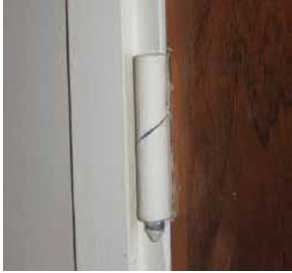
332. Existing fire-resisting doors need to be a good fit within their frames with a maximum of 4mm gaps between the sides and tops of a door and the door frame. The gaps at the base of the door should be limited to 6mm. The doors and frames should be in good condition, undamaged, and have no openings in them where locks or security fastenings have been removed. The fire resistance of frames should not be compromised where cables pass through the frames into flats.
333. Where a fire-resisting flat entrance door has been inappropriately replaced with a non-fire-resisting type by a resident, the non-fire-resisting door should be replaced with a new FD30S door.
334. Testing of fire doors in 2018 by the UK Government’s Ministry for Housing, Communities and Local Government (MHCLG) revealed that some existing glass reinforced plastic composite fire doors failed to demonstrate the claimed period of fire resisting duration. These doors are often used as flat entrance doors. Where doors that have failed tests are installed, building owners should review their building fire safety risk assessments and consider how quickly these doors should be replaced. Test evidence should indicate that both sides of the door have been tested and meet the criteria required. Further information can be found at https://www.gov.uk/guidance/fire-door-investigation.
Final exits and exit capacity
335. The number and capacity of exits will rarely present problems although communal meeting rooms may need to be assessed based on the number and width of exits available. Final exits should be clear of fire hazards and should allow people to exit the building safely.
336. Final exit doors from the building should be easily openable from the inside without the use of a key or code. A simple turn handle or lever that can be easily operated by older or frail residents is preferred. Locks operated by thumb turns are unlikely to be suitable, as they can be difficult for frail residents to open. For doors that are normally secured and used only as a fire exit, a panic bar or push pad is more suitable. Exits fitted with electronic locking mechanisms should comply with the recommendations of BS 7273-4.
337. Final exits and exit routes should not present an obstruction to residents who use mobility aids. Where possible, exits should have a level threshold leading to level ground to allow people to make their way clear of the building to a place of safety. The surfaces of external exit routes should not present a slip or trip hazard. They should be regularly inspected to avoid, for example, a build-up of vegetation or algae and, during winter periods, a build-up of snow.
(2) Means of Escape in Supported Housing / Small Care homes
338. Most supported housing and small care homes are akin in design to single-family dwelling houses, albeit that most residents have their own rooms and share common facilities. The assessment of means of escape starts with an assessment of the residents and their ability to evacuate in the event of a fire (see Part 1 of the Guidance).
339. Where residents are capable of responding appropriately in the event of fire (or alarm), means of escape will be similar to a single-family or shared house. Assuming a comprehensive level of fire detection is provided, the premises should be regarded as low risk.
340. If residents use wheelchairs to evacuate, fire exits need to be wide enough. Some residents may require staff assistance and for very high risk residents, measures such as additional fire detection, upgrading of fire doors and, in some cases, automatic fire suppression may also be necessary.
341. Travel distances will not normally be an issue but should not exceed 9m in a room, or in a single direction of escape. Overall travel distance to a final exit should not exceed 18m. A degree of flexibility should be applied to travel distances, depending on the level of risk.
342. Smoke seals should be fitted to fire doors (or frames) where staff assistance is required to evacuate residents or where prolonged evacuation times are anticipated, such as in small care homes. If upgrading doors with intumescent strips, or replacing doors with new 30 minute doorsets, they should also be fitted with smoke seals.
343. Where fire-resisting, self-closing doors present an obstacle to normal access and egress, consideration should be given to fitting hold open devices or swing-free arms. Further information on fire doors and final exits can be found in the preceding Means of Escape section for Sheltered / Extra Care Housing (see pages 60-63).
344. Ideally, gas meters, electricity meters and distribution boards should not be sited in escape corridors or stairways, although if they are located at high level and are not accessible to residents, they should present little risk (provided they are installed and regularly inspected in accordance with gas safety regulations and current IET regulations). Those at low level should preferably be enclosed in fire-resisting construction and be secured to prevent unauthorised access.
Means of escape - single storey ground floor
345. In single storey ground floor premises (bungalows or ground floor flats), the means of escape requirements will be limited and relatively simple to achieve, and will be similar to those found in single-family dwellings. Doors to each room should be of sound construction and fit closely into their frames, but need not be fire resisting, unless prolonged evacuation times are anticipated.
Figure 13: Single storey layout
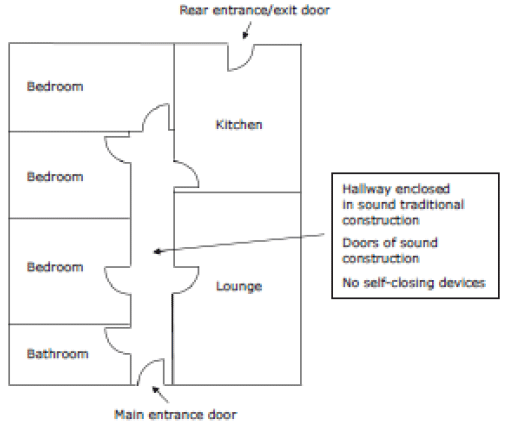
Means of escape – 2 storey premises
346. The means of escape in two storey premises (with no floor more than 4.5m above ground level), will also be relatively simple. Habitable rooms on the ground floor should either have a final exit door, or, alternatively, a door that opens onto a hallway, which, itself, leads directly to a final exit. If habitable rooms are provided in the basement, they should have a final exit or a door that opens onto a protected stairway which leads directly to a final exit at ground level.
347. Stairways should be a protected route enclosed in 30 minutes fire resisting construction and doors to all rooms (other than toilets, shower rooms and bathrooms) should also provide 30 minutes fire resistance. Stairways should either lead directly to a final exit, or gives access to two separate escape routes, which are separated by fire-resisting construction and lead to final exits.
348. In lower risk premises, this may be a nominal period of 30 minute fire resistance with solid, well-fitting doors (hollow core or thin panelled doors should be replaced) and there will not normally be a need to fit self-closing devices to fire-resisting doors. In other premises, doors to kitchens or lounges that open directly onto a protected stairway should be fitted with positive action self-closing devices.
Figure 14: 2 storey layout
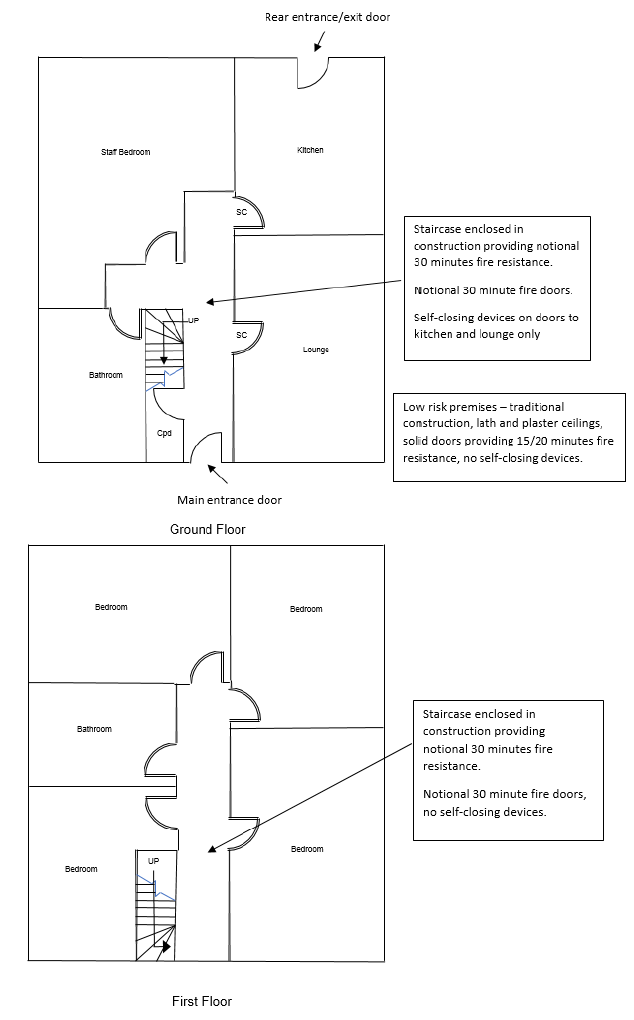
Means of escape – ground and two upper floors
349. The means of escape in three storey premises should consist of a protected stairway that leads directly to a final exit, or gives access to two separate escape routes, which are separated by fire-resisting construction and lead to final exits. The stairway should be enclosed in 30 minutes’ fire-resisting construction, and doors to all rooms (other than toilets, shower rooms and bathrooms) should afford 30 minutes’ fire resistance (FD30 doors). This includes construction and doors to cupboards that contain a source of ignition.
350. In low risk premises, and premises protected by a sprinkler or watermist system, original, traditional construction (for example, lath and plaster) in sound condition is acceptable; original, solid, well-fitting nominal doors that would be likely to provide a fire resistance of around 20 minutes are also acceptable, but hollow core or thin panelled doors should be replaced. Self-closing devices need only be fitted to the doors of a lounge or kitchen that opens directly onto a protected stairway. In other premises, all fire-resisting doors that open onto a protected stairway should be self-closing.
351. If a prolonged evacuation time is anticipated, notional FD30 doors should be upgraded by fitting intumescent strips to the head and vertical edges of the doors; alternatively, new, certificated FD30 doorsets may be installed.
Figure 15: 3 Storey layout
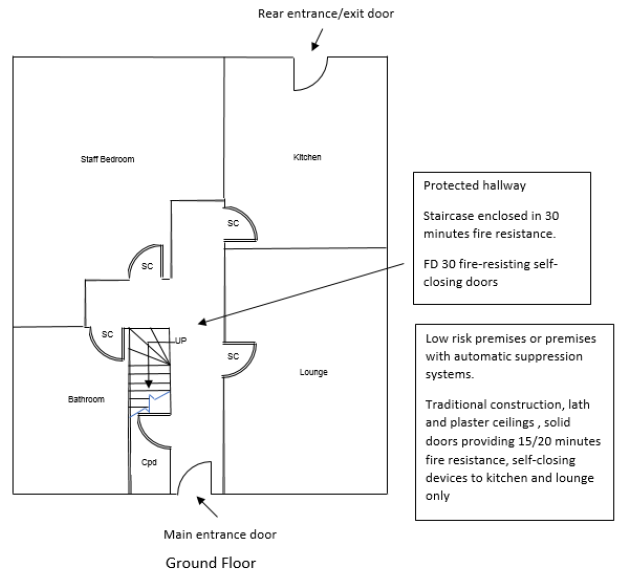
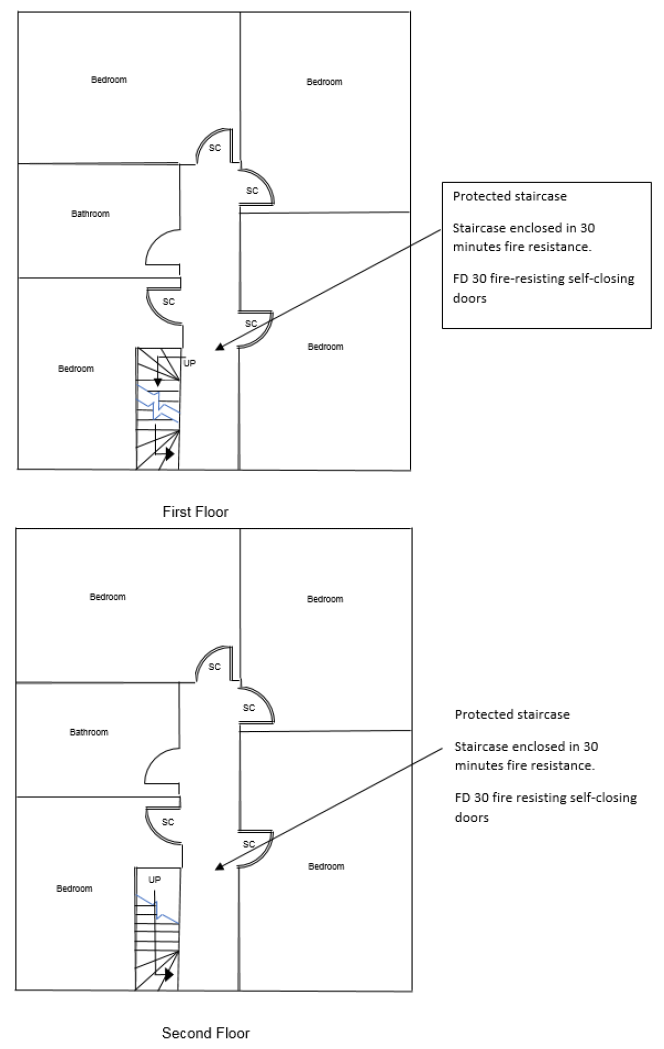
Means of escape – properties of four or more storeys
352. Four (or more) storey supported housing is uncommon. Specialist advice on means of escape from such premises will be required.
Fire Safety Signs
353. Signage may be required where there are alternative exit routes or where there is potential for confusion. Smaller premises and those with a single staircase would not usually require fire exit signage. The excessive use of signs should be avoided, particularly in supported housing.
354. ‘Fire Door Keep Locked Shut’ signs should be provided on the following fire-resisting doors:
- The external face of doors to store rooms.
- Electrical equipment cupboards.
- Ancillary rooms located within the common areas.
355. ‘Fire Door Keep Shut’ signs should be provided on both faces of fire-resisting doors forming part of the protection to the common escape routes and on cross-corridor fire doors, but not to flat entrance doors. In the case of fire doors that are held open, and release on operation of smoke detectors, the signs should read ‘Automatic Fire Door Keep Clear’.
356. New safety signs should comply with BS EN ISO 7010.
Lighting on Escape Routes
357. Emergency escape lighting should be provided throughout escape routes, other than in small premises of no more than two storeys with adequate and reliable levels of borrowed lighting i.e. from external street lighting.
358. In small supported housing where borrowed lighting is unavailable, automatic plug-in night lights, that continue to operate if the mains electricity fails, may be provided within the hallway and upstairs landing (if applicable). Where residents’ rooms do not receive borrowed lighting throughout the night, the night light should be of a type that can be removed from its socket or mounting to be used as a torch.
359. In other cases, emergency escape lighting should conform to the recommendations and requirements of the relevant parts of BS 5266. It should provide illumination for three hours in the event of power failure.
360. One or more test switches should be provided, so that the emergency escape lighting can be tested by simulating failure of the normal power supply to the luminaires without the need to isolate normal lighting circuits.
Fire Detection and Alarm Systems
Supported Housing / Small Care homes
361. A Category LD1 fire detection and alarm system complying with the recommendations of BS 5839-6 should be provided. This requires a heat detector in the kitchen and smoke detectors in all circulation spaces and all other rooms (excluding toilets, shower rooms, bathrooms).
362. Optical smoke alarms are recommended in circulation spaces and areas into which kitchens open. Multi-sensor alarms may be used to limit false alarms, for example, where steam from bathrooms may enter hallways. There will normally be no need for fire detection within roof voids, unless these contain significant fire hazards such as gas boilers or photovoltaic electrical equipment.
363. In a single storey premises and for premises with no more than four bedrooms, Grade D1 (mains with tamper proof standby supply) domestic alarms are recommended.
364. In other premises, a Grade A system with control and indicating equipment, fire detectors and fire alarm sounders, should be provided. Existing premises of up to two storeys with a Grade D system should upgrade to Grade A when the smoke alarms reach the end of their lifespan. Where there is less than two members of staff on duty, the system should be addressable or there should be remote indicator lamps outside the entrance door to each resident’s accommodation, so that the location of a fire can be quickly identified.
365. The standby batteries for a Grade A system should be able to operate the system for 72 hours in the event of mains failure, after which there should be sufficient capacity to sound an evacuation signal for 15 minutes. In premises with at least one member of staff present (whether awake or asleep) on a 24-hour basis, the period of 72 hours may be reduced to 24 hours.
366. BS 5839-6 recommends that the sound pressure level of the fire alarm signal should be at least 85dB(A) at the open doorway of every bedroom, but might need to be a higher level of 75dB(A) at the bedhead of each bedroom. This higher level will be achieved in Grade D systems from the smoke alarms in bedrooms, as they acts as both a fire detector and sounder. In the case of Grade A systems, fire alarm sounders (which may be incorporated in the base of each detector) should be installed in each bedroom.
367. In areas other than bedrooms, the sound pressure level of the fire alarm system can be lower than in commercial premises. A sound pressure level of 55dB(A) will be sufficient. Care should be taken to ensure that the sound pressure level, frequency and other characteristics do not cause a serious adverse reaction from residents who are sensitive to alarm signals as the result of mental health problems. In such cases, alternative forms of warning, such as visual alarm devices or voice sounders, might need to be considered. More information on systems designed to meet the needs of the person can be found in Part 1 of the Guidance (Person Centred Approach).
368. In continuously staffed supported housing with a simultaneous evacuation strategy, it is not normally necessary for alarm signals to be transmitted to an alarm receiving centre. Where there is no 24-hour staff presence, or there is uncertainty that staff will summon SFRS immediately, remote monitoring of fire alarm signals by an alarm receiving centre is recommended. Where this is the case, there should be arrangements to minimise false alarms and to avoid summoning SFRS unnecessarily.
369. Manual call points are not normally necessary. They may be considered as part of a Grade A system if a verbal warning of fire is unlikely to be heard throughout the premises.
370. If supported housing takes the form of small flats or bedsits in which smoke detectors might result in false alarms (for example, as a result of smoking or cooking), a “mixed system”, as defined in BS 5939-6 may be acceptable. Residents must be able to respond appropriately to an alarm in their own accommodation. Warning is given by a Grade D system, comprising mains-powered, interlinked detection. A Grade A system is provided in the common parts, with smoke detectors in all circulation areas and rooms, other than toilets, shower rooms and bathrooms. Sounders and heat detectors forming part of the Grade A system are installed in each resident’s accommodation. Heat detectors rarely cause false alarms, and are much slower to operate than smoke detectors, but will give a warning to other residents in the event of a significant fire.
Sheltered/Extra Care Housing and other private dwellings
371. Automatic fire detection in each flat (or house) should comply with the recommendations of BS 5839-6 for a Grade D Category LD1 system (see paragraph 361 above for details). A Grade C system should be considered if elderly or disabled people are expected to test or silence alarms within their flats as this can be done at floor level using Control and Indicating Equipment.
372. All alarms should be ceiling mounted and interlinked. Smoke detector(s) in each flat should not give warning beyond the flat. They should be monitored by an on-site scheme manager (if present) and by an alarm receiving centre at all times when a scheme manager is not present. This is to ensure SFRS are summoned without delay. This is important in premises with a “stay put” strategy to ensure that a fire is extinguished quickly or to instigate an evacuation beyond the flat of origin if the fire proves difficult to bring under control. Evacuation may take longer than in a general needs block of flats and residents may be particularly vulnerable to smoke within escape routes. The likelihood of successful rescue is increased if the fire service are quickly on the scene.
373. Telecare monitoring is preferred as it allows two-way speech between the alarm receiving centre (ARC) and each flat, so that false alarms can be filtered.
374. Safeguards are necessary to ensure alarm signals are reliably transmitted by social (“Telecare”) alarm systems. A signal must be transmitted, regardless of which smoke or heat detector operates. Fire signals need to be readily distinguishable from other social alarm signals and should not be delayed. At the very least, the display at the ARC should clearly indicate a waiting fire alarm signal.
375. In schemes with communal facilities, a Grade A communal fire alarm system compliant with BS 5839-6 should be provided. This should not give an evacuation signal within the flats (ideally, the sound pressure level within the flats should not exceed 45dB(A)). Manual call points should be provided within the common areas. The system should also be monitored by an alarm receiving centre.
376. No communal system is necessary in simple sheltered housing that, architecturally, is similar to a general needs block of flats with no communal facilities. Fire detection can be limited to the remotely monitored smoke and heat alarms in each flat. Smoke detection might be necessary to operate automatically opening vents. In this case, the smoke detection should generally be installed in accordance with the recommendations of BS 5839-1, except that no sounders should be provided. Manual call points are not required.
377. Detection does not need to be installed in roof voids, provided the separation within roof voids satisfies the recommendations of this Guidance and there are no significant fire hazards (for example, boilers, photovoltaic systems and significant volumes of combustible storage). Where hazards are present, the type of detection and its fire warning strategy will depend on the location of the hazards. If the hazards exist in the void above a flat, the detection may comprise smoke alarms linked only to the smoke alarms in the flat. If the fire hazards exist within a void over common parts, the fire detection should give a warning in the common parts.
378. As a further enhancement, heat detectors connected to a communal system could be installed within the hallway of each flat, to provide confirmation of a fire within a flat. This is in addition to each flat’s own LD1 system, as heat detectors would not summon SFRS early enough. If a heat detector operates, it might be appropriate to evacuate adjacent (or all) common parts. If staff are present on a 24-hour basis, it may also be appropriate to evacuate flats in the immediate vicinity.
Automatic Fire Suppression Systems
379. Automatic fire suppression systems in domestic premises are primarily designed for life safety purposes. They can provide vulnerable occupants with additional time to escape in the event of fire. Also, fire damage and disruption is usually greatly reduced.
380. Systems react to heat and so the greatest protection is afforded to those occupants outwith the room of fire origin. The spray pattern delivered from the sprinkler heads should control fire spread. Whilst the effect of sprinkler spray will increase the smoke volume and could obscure exits, smoke temperatures and toxicity will be greatly reduced. The fire might even be extinguished if it is not shielded from the sprinkler spray.
381. Automatic fire suppression systems includes sprinkler systems but can include other systems which may be just as effective. The key characteristics are:
- It must be automatic and not require people to initiate its activation.
- It must be designed primarily to protect lives, rather than property, which means it should be fitted with faster responding discharge heads.
- It must be a fire suppression system, one designed specifically to deal with fires rather than other hazards.
382. Retrofitting suppression may compensate for fire safety measures that are so far removed from current standards that they present serious risk to residents. Retrofitting is likely to be necessary if residents need assistance to evacuate but staff are not always available to help.
383. Sprinkler systems should be designed and installed in accordance with BS 9251, but may be installed in accordance with BS EN 12845. For sheltered housing, extra care housing, small care homes and for supported housing in which residents cannot evacuate without the assistance of staff, systems installed in accordance with BS 9251 should satisfy the recommendations of that standard for a Category 2 system. In other supported housing, a Category 1 system will normally suffice. Watermist systems should be designed, installed and commissioned in accordance with BS 8458.
384. Concealed or recessed pattern sprinkler heads can be rendered ineffective or operate less efficiently due to decorative ceiling finishes. Therefore, consideration should be given to labelling of the heads with words 'DO NOT PAINT'.
385. Designers should liaise with Scottish Water to determine what supply is likely to be available and what pressure can be expected. Pressures can be variable and may change over time. It is imperative that the system is designed on the basis of what the minimum pressure and flow is likely to be. If there is any doubt, a tank and pump arrangement should be used.
386. Water supplies should use a direct connection to a town main if possible. A dedicated booster pump may be needed if pressure is insufficient or to achieve the higher pressures required for watermist nozzles.
387. If a pump is used, a duty pump and a standby pump will be required. The standby pump automatically takes over if the duty pump fails (duplication is not necessary for personal protection watermist systems). There should be a suitable standby power supply for the pumps, comprising secondary batteries of sufficient duration to operate the system for the minimum duration over which the system is required to operate. Further guidance on performance, reliability and resilience for sprinkler and watermist systems installed in the homes of vulnerable people can be found in Annex B of BS 9251 and Annex B of BS 8458 respectively.
388. Suppression systems may not be required to protect common corridors or staircases in some sheltered schemes, unless those areas contain combustible materials.
Portable Fire Extinguishing Equipment
389. Fire extinguishers are not required in the common areas of sheltered or extra care housing, but should be provided in plant rooms and staffed areas such as laundries, common lounges, kitchens, hairdressers, staff rooms. They should only be used by trained staff; it is not appropriate for residents to use firefighting equipment. Their provision in the common areas might encourage residents to return to their flat to fight a fire.
390. In the majority of supported housing and small care homes, portable fire extinguishers and fire blankets should be provided for use by trained staff only.
391. Extinguishers should be installed in accordance with BS 5306-8. In single storey supported housing with no more than four bedrooms, fire extinguishing appliances may be limited to a single fire extinguisher with a 13A rating and a fire blanket in the kitchen. Fixed hose reels should be removed.
Facilities and Assistance for Firefighters
392. Firefighting facilities for SFRS may have been required under Building Regulations in larger, more complex premises. Vehicle access for fire appliances should always be maintained. In sheltered and extra care housing, smoke control systems may be provided. In larger schemes, there may be rising fire mains, firefighting shafts and firefighters lifts.
393. There is not normally a requirement to provide or upgrade firefighting facilities in existing premises but it may be considered as part of a planned refurbishment programme in older premises. Existing facilities must be maintained in efficient working order (see Part 3 of the Guidance).
External Fire Spread
394. The external facades of buildings should not provide potential for extensive fire spread. Particular attention should be given to wooden balconies, balcony infills, spandrel panels and rain-screen or other external cladding system.
395. Combustible cladding materials and extensive cavities can present a risk, particularly in taller or complex blocks. Restrictions are normally applied to the nature of materials and their fire propagation and surface spread of flame characteristics. Cavity barriers are also required.
396. Assistance from specialists may be required to determine if the construction and materials are satisfactory and whether there is adequate provision of cavity barriers.
Contact
Email: FRUInformation@gov.scot
There is a problem
Thanks for your feedback